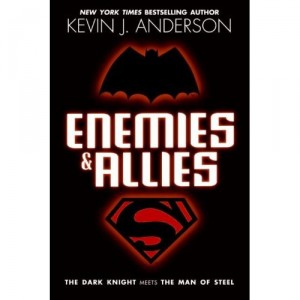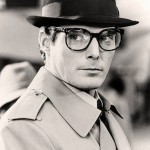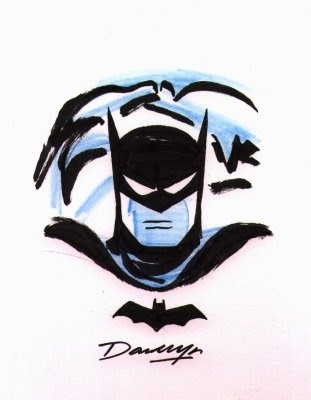Media Madness: Words & Pictures, Enemies & Allies
In Media Madness, Matt. Murray reviews, revisits and rambles about comics, cartoons and their interactions in and with related media.

In Media Madness (on Mondays and other days) I’ve focused much of my attention on adaptations of comics into movies, television shows and other temporally sequential art forms. Largely, that’s probably what one thinks of when one mentions the adaptation of the comic medium into another. However, there is a whole other strain of adaptation that has been around basically since the birth of the comic itself: the translation of comics and their characters into other print media that lack pictures… short stories and books.
Historically, Stan “The Man” Lee’s first job at Timely comics was writing “Captain America Foils the Traitor’s Revenge” a text-only filler story that ran in Captain America #3. Pieces like this were a necessity for comics in the Golden Age, so that a comic could be considered a proper “magazine” making it eligible for a mailing certificate with USPS. To this day, there still exists a school of thought that comics are in some way a lesser form than text-only fiction, simply because they have pictures.
I actually witnessed an institutionalized version of this “thought” first hand a couple of years back at a conference of Nassau County Public Librarians. I was invited to their annual breakfast to speak on a panel in favor of the comic book as a form of adult literature, and although I applaud the organizer for even trying to posit this thought into the head of her colleagues, the feeling of the room was essentially summed up in the closing comment of an attendee who stood up thanked the panel for coming and then shook her bee-hived head and said “…but these ‘books’ are still for children.”
If you’re reading this blog, you probably are encircled by a group of friends who understand that comics are a completely legitimate form of expression. You might not have to have regular arguments with people in order for them to see the medium’s value. Don’t let that bubble lull you into a false sense of security though…
Don’t let the intellectuals who insist that there is a difference between comics (low art) and “comix” or “graphic novels” (High Art) trick you into some kind of belief that certain books are universally accepted. Because they’re not.
Don’t let the fact that you may be under 40 and have essentially grown up with the understanding that comics can be literature (largely due to Maus being on almost every high school reading list since it won the Pulitzer) fool you. Because most of the world’s population does not agree.
Thankfully, for those of us want their comic fix but are still chained to the apathy and condescension of the Baby Boomers and the so-called Greatest Generation, it seems that companies still publish text-only adventures of superheroes and others and they’re readily available at your local bookstore right next to their smarmy cousins – the graphic novels and trade paperbacks!
Now, I have to admit that I’ve never really dove into the “Expanded Universe” of any franchise – although I dipped my toes in the waters of Indiana Jones adventure novels and of course, Timothy Zahn’s first three Star Wars books (aka The Thrawn Trilogy; aka Episodes 7-9, etc.) I’ve always had a dim awareness of these other books like the numerous Spider-Man or Hellboy novels, but I never gave any of them a whack though. So, it was with only a mild sense of surprise that I opened a package from an “Early Readers” club that I belong to and saw that I had received a new Superman/Batman novel called Enemies & Allies.
Taking an Elseworlds style approach to the characters, Enemies & Allies is set during the late 1950s and examines an alternate continuity where Batman and Superman meet and form an uneasy alliance against Lex Luthor, who of course has designs on taking over the world starting with Wayne Enterprises. Without giving too much away, the story plays hard and fast with Cold War themes such as the space race, nuclear escalation and McCarthyism (the Senator from Wisconsin, himself even plays a part.) Superman cast members Lois Lane, Jimmy Olsen, Perry White and Ma Kent all make appearances, as do Batman‘s Alfred the Butler and Commissioner Gordon. The book is also littered with allusions to DC characters like Ollie Queen, and historical figures such as President Eisenhower.
Written by Kevin J. Anderson — who has evidently made quite the name for himself in the Expanded Universe trade with best selling forays into the literary worlds of Star Wars and X-Files under his belt, as well as nearly a dozen Dune sequels — the book is a basically easy and mostly entertaining read. What stands out distinctly about Anderson’s writing is almost a complete lack of detailed description of characters and actions, especially in regard to the leads, which creates, in a sense, the exact opposite experience one would have in reading a World’s Finest comic. It becomes the job of the readers to cast and compose each panel in their mind’s eye, as thoughts and motivations are fed to them.

Regular readers of this blog know from past posts and discussions that the concepts of “ideas” and “ideals” of comic characters have popped up a few times over the past couple of weeks (ed: most notably here and here). It’s a particularly interesting notion in light of reading this book and perhaps other text-only “Expanded Universe” fiction as those works, especially this one, work on the supposition that there is an agreed upon standard of Superman – that has black hair, blue eyes, and a blue suit with a red and yellow “S” emblazoned on the chest.
I found that when left to it’s own devices, my imagination had it’s own ideas of what pictures were triggered when it ran across the words “Clark Kent” or “Superman” and the two men were vastly different — finally allowing me to commiserate with Lois Lane and her failure to recognize that they were one in the same. All those decades of suspending my own disbelief washed away in the process of reading a few prose paragraphs. As I read the book, I envisioned Christopher Reeve as Clark Kent interacting with a Flesicher-esque Lois Lane (I guess because of the period clothing), before morphing into an Alex Ross Superman and flying off to Area 51 to encounter Batman.


Interestingly enough, Batman was tough to “cast” as he is often described as wearing “armor,” which to me invokes a post 1989 movie image of head-to-toe rubber or Christian Bale’s modern ceramic plates. Though it tried, my mind could find no “armor” that could fit practically under the union suit worn by a Shelly Moldoff or Wayne Boring style Bruce Wayne. Ultimately I found my brain skipping the writer’s descriptions and just settling on it’s own image of a pre-“New Look” makeover Darwyn Cooke Batman from Justice League: New Frontier. Again, this is probably because my imagination was skewing toward 1950’s period to match the time frame of the book.

Strange… that the fundamentally unacceptable conceit that Clark Kent and Superman can be viewed as separate people in the visual media of comics and films can just be simply accepted when transferred to the written word and then projected onto the mind’s canvas, while a whole concept of a character can be lost with the use of one dissonant word invoking the weight of 70 years of technological progress. Anderson’s word and my mental pictures were as much the titular enemies and allies as the Man of Steel and the Dark Knight.
While it was certainly a more complex experience, I wouldn’t characterize it as a more enjoyable, adult or even a more “literary” experience than had I read the story as a graphic novel. The two worlds, with and without pictures would be like comparing well, Batman and Superman. Both have their apparent strengths and after a while, they reveal their secret weaknesses. Anyone who hasn’t dabbled in the worlds of text-only Expanded Universe lit, I recommend going to their local bookstore when its released on May 5th and picking up Enemies & Allies, or if DC heroes aren’t your bag there are also plenty of Spider-Man, Hellboy, Wolverine books and even a Sandman collection out there. Somethings bound to catch your attention.
Just remember, if you happen to pick any of those up at your public library, you might not want to ask where the “real” comics are – you know, the ones with the pictures – you might end up exiled to the children’s section.
Matt. Murray earned his BFA in film, television and radio production from NYU. He has curated exhibits focusing on the art and commerce of Saturday Morning cartoons and the adaptation of illustrated media into live actions films and animation. Murray is the country’s leading (if not only) Smurfologist. His personal blog, It’s Time for Some Action, can be found at http://actnmatt.blogspot.com/



I’ve always wondered abut the book adaptations of comics heroes and wondered how it worked. I have a hard time imagining the justification of the powers without pictures to cement their existence. Prose is such a great medium for learning the make up of a psyche that I would almost be afraid to see how far into the head of Superman or Batman one would go.
They both tend towards being men of action and often they are defined more through what they are doing than what they are saying.
That being said, did you feel that superheroes in this medium worked independently or were the characters dependent on knowledge of the comic version?
Also, my heart breaks when I hear about these “comics are for children” stories. It is nice to know that that mindset is going the way of tattoo-prejudice and the wanting of the damn hippies to cut their hair.
Hard to say, as I have more than just a passing knowledge of Superman and Batman in their original comic book forms, their adapted live action and animated forms, etc. I already know that the characters should work and how they work, so let’s say that even if they didn’t “work” in this particular instance, my brain was pre-disposed to making them “do it.” Again, perhaps that’s why the prose was devoid of too many details or explanations, it’s just assumed that whatever is in there is agreed upon that it will work – and I’m sure there are editors on the ball at the comic companies and the publishing houses that are there to ensure that there’s no deviation too far from the “original.”
I wonder what it would be like to approach an “Expanded Universe” novel from the perspective of not knowing how the characters or their universes work. Although as they’re “Expanded Universe” books, I imagine the point is that people know what to expect from them for the most part, and that’s why they buy them — to get that kind of thrill that they’re used to in a book format… (Man, in re-reading that last sentence I kind of feel like these are the Harlequin Romances of the Super Hero set.)
While it is nice to know that serious in roads have been made, especially in the last 25 or so years, I think even you realize (having encountered what could be construed as a similar problem in your last post) that there still is a larger community out there that are more outside the circle than in. As morbid as it sounds, I’d like to think that it’s a numbers racket and that perhaps as the herd of people who hold on to those archaic beliefs thin out, that the next generations will fill in the gap with some knowledge and understanding. Unfortunately, now that I live in a suburban community where there isn’t as prevalent or prominent an arts set (or a group that understand that comics are good and good for you), I do see that we and the medium still have a long way to go. I think we still are a fringe community to an extent, and although many of us are not the Comic Book Guy (but let’s face it, he is out there) – we still do live in his shadow… for now.
On the tattoo front – I just literally signed off on the fact that I don’t have any visible ones and that I won’t be getting any while I work at my current job… So, it looks like there still may be a bit of a way to go on that battlefield, and that I’ll have to keep the next one under my sleeves as well – and if anyone wants to vote on what the next one will be they can go HERE!
The thing that makes me laugh about it really is that you almost never meet people with a problem with tattoos, comics or long hair. It’s a bunch of people worried about the impression that these things are going to make on the IMAGINARY people who have a problem. And, you’re right, it is a numbers racket and it only takes time and communities to stand up for art and for what truly is the popular opinion instead of the spineless kowtowing to a strong IMAGINARY minority that they believe is out there.